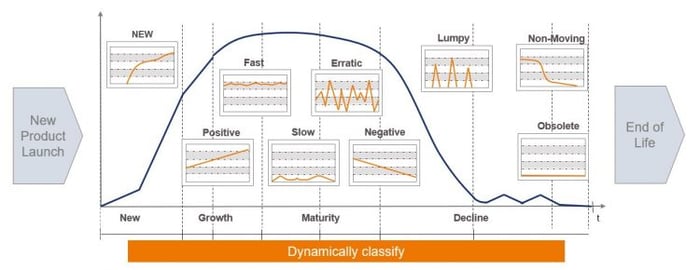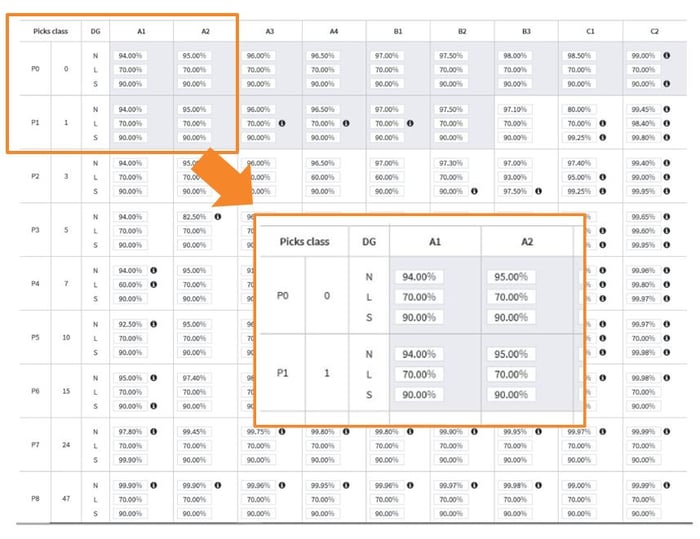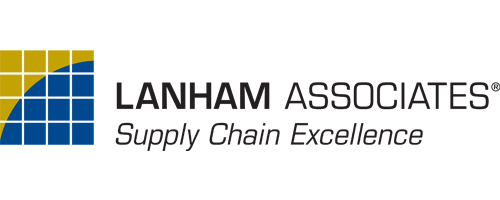The Coronavirus pandemic has highlighted many weaknesses in supply chains across the globe. Common challenges include unpredictable customer behavior, unreliable inventory supplies, rising logistical costs and internal capacity constraints.
It’s already apparent that those supply chain management (SCM) teams that can adapt their operations and respond quickly to these issues will be one step ahead of their competition.
Businesses of all sizes are turning to supply chain digitalization and technology for answers, which, in turn, will transform the way they work forever.
Inventory optimization software is an important piece of the puzzle. It is critical to helping inventory management teams understand and manage demand and supply variables. It also offers improved efficiencies and powerful data insights, providing a wealth of functionality to help during these difficult times.
In this four part blog series we discuss how inventory management teams can use inventory optimization to help deal with the impact of the Coronavirus in the medium and long term, focusing on demand forecasting, inventory planning, and supply chain disruption. We start with a brief overview of all three topics.
Save Time by Automating Inventory Management Calculations
Many inventory management teams spend too much time manually calculating forecasts, turnover rates, safety stock and reorder quantities – analyzing results, tracking KPIs and continually updating the numbers. The process is endless.
Even sophisticated Enterprise Resource Planning (ERP) or Warehouse Management Systems (WMS) rely heavily on users manually inputting forecasting and replenishment parameters to automate any form of reordering alerts. But, with global supply chains in a state of flux, every hour that teams can save by using automation to remove this burden is additional time they can spend on more strategic tasks.
The era of using spreadsheets to run reports and analyze data is over. Organizations are introducing software to drive efficiency right across their operations – from financial analysis to marketing automation. It’s now time that inventory management teams did the same.
How Inventory Optimization Software Works

Inventory optimization software, such as EazyStock, plugs into ERPs and WMS to automate forecasting, planning and replenishment tasks. The software automatically generates order proposals, which are dynamically calculated based on factors such as demand forecasts, dynamic stocking policies, target service levels, supplier lead times and internal constraints.
Taking all these variables into account, reorder points and quantities are set, and a daily list of recommended orders is produced to feed back into your ERP to create purchase orders.
An inventory optimization tool does all the heavy lifting, so you can ‘manage by exception’, using software to flag issues that require additional human input. For example, highlighting unusual dips in demand or longer than expected lead times.
Here are some specific ways that inventory optimization software will help you overcome inventory management challenges during the Coronavirus crisis.
Combating Demand Forecasting Issues Caused by the Coronavirus
Inventory optimization software, such as EazyStock, uses a powerful statistical demand forecasting engine to automatically generate forecasts for every item in your supply chain. These will be much more accurate than using a 30-day rolling average calculation in Excel or an ERP. Rolling average forecasts are only suitable when demand is stable and, right now, this is simply not the case. In contrast, EazyStock classifies each item into one of nine different demand types, based on its demand pattern, and then uses the relevant algorithm to produce the most accurate base forecast it can.

Identifying Changes in Demand
As countries (even regions) continue to modify social distancing policies, tracking demand trends will be critical to ensuring your stock levels match your customers’ needs. A good forecasting tool will identify demand trends at SKU level and adjust forecasts accordingly. With marketplaces changing daily, forecasts can be regularly reviewed, allowing you to optimize sales revenue, without a build-up of unwanted stock.
Adding Qualitative Insights
All demand forecasts will benefit from qualitative insights that no machine can predict. Feedback and data from your sales team, customers and industry bodies can easily be added to forecasts to help fine-tuning.
Dealing with Inaccurate Demand Forecasts
With social distancing policies impacting customer behavior, even the most powerful forecasting tools will find it hard to produce projections that are 100% accurate. To overcome this, the best inventory optimization tools, like EazyStock, have built-in reports and alerts to act as a safety net. For example, EazyStock will:
- Track actual demand throughout the forecast period and alert you when it’s differing significantly from the forecast. These early warnings allow you to investigate the cause and keep an eye on items going forward.
- Highlight demand outliers at the end of a forecasting period (e.g anomalies in the forecast compared to actual consumption) so you can decide whether to include the figures in the upcoming forecast.
- Generate a daily risk-of-runout report that details stock items at risk of going out of stock so you can form a plan of action.
Optimizing Stock Levels to Help Prevent Stockouts During the Coronavirus Pandemic
Moving forward, every inventory manager will need to closely track and identify stock items that are business-critical and react accordingly to alleviate supply risks. Inventory optimization tools, such as EazyStock, offer great stock classification and analysis functionality to help.
Identifying and Managing Critical Stock
With cashflow tight, businesses need to invest wisely in stock that will generate revenue and not sit in the warehouse. Many inventory management teams use the ABC classification model to segment stock items based on their value to the business. They then set different stocking policies to prioritize availability of their category A items (that generate the most money), over B, and then C items. However, ABC analysis is a very manual process and inventory segments are quickly out-of-date, making it unsuitable for helping you keep up with today’s dynamic marketplaces.
In comparison, EazyStock automatically analyzes and classifies stock items based on a range of variables, including the cost of goods sold, pick frequency, demand volume and volatility. The result is an inventory matrix with 243 segments. Stocking rules are then automatically applied (which can be manually adjusted based on your market’s dynamics) to help achieve your target service levels (stock availability goals).

Every day EazyStock updates the inventory matrix, moving items between categories and automatically updating stocking rules, as required.
With inventory levels dynamically optimized, you can invest funds in the right stock items to keep stockouts to a minimum while reducing the risk of excess inventory piling up.
Redistributing Inventory Across your Supply Chain
With the supply of many inventory items disrupted, it’s important to identify and use excess stock currently within your supply chain. Excess stock could include goods reserved for markets in lockdown, items sitting in stores currently not selling, or even obsolete products superseded by newer models. With EazyStock you can easily identify this stock and redistribute it to locations with healthy demand to help alleviate supply pressures and help prevent stockouts.
Ensuring Continuity of Supply Despite the Coronavirus Crisis
Securing supply is possibly the hardest task for inventory management teams right now and, as suppliers return to ‘business as usual’ at various rates, supply issues could be here to stay.
Inventory optimization tools, such as EazyStock, are designed to manage variances in supplier lead times, overcome supplier constraints and secure the most cost-efficient means of replenishment. Here’s how:
Dealing with Variable Lead Times
EazyStock’s dynamic lead time feature helps mitigate the impact of supply delays on fulfillment. It does this by tracking actual lead times and sending alerts when they begin to deviate from the norm. You can then either manually adjust replenishment parameters e.g reorder points and quantities, safety stock etc, or let the system update them automatically.
Aiding Supplier Discussions
Having open and honest communication with your suppliers about their fulfillment capabilities will be key to alleviating bottlenecks in supply. Using EazyStock’s order scheduling functionality, you can create future order projections (based on your forecasts and their lead times) for your suppliers to feedback on. Where supply risks are apparent, you can devise a Plan B: for example, rationing stock across your business, raising prices to lower demand, or looking for alternative suppliers.
Deciding Which Supplier to Use
When placing replenishment orders, you may find you have a number of suppliers to choose from. Often you’ll get a lower unit price by using the supplier with the higher minimum order quantities (MOQ) and longer lead times – and visa versa. But with Coronavirus impacting all these variables, this rule may no longer apply and sometimes it may be wiser to pay more for shorter lead times to ensure stock availability.
EazyStock can help by recommending the supplier who can fulfill the order within a lead time that meets target service levels, while doing so in the most cost-effective way. For example, if an item is at risk of runout, it will recommend ordering the MOQ from the supplier with the shortest lead time and ordering the remaining stock from a more cost-efficient merchant.
Working Around Operational Constraints
With many workers currently furloughed, working from home or shielding, you may need to adapt your usual order processing procedures. EazyStock’s order calendar feature let’s you enter the days when you want to place orders (based on you or your suppliers’ internal constraints). It then automatically recalculates reorder quantities and safety stock levels to prevent these issues impacting stock availability.
EazyStock: A Smarter Response to Coronavirus Inventory Management Challenges
To respond effectively to the challenges of Coronavirus, your team needs to be focused on managing customer expectations and solving supply chain disruption. You therefore need to reduce the time they spend processing data, manually forecasting demand and calculating replenishment parameters.
EazyStock offers an easy-to-implement solution that delivers an ROI within months of go-live. Inventory planners instantly have the ability to operate smarter and more efficiently. In turn, businesses will see fewer stockouts and lost sales, while freeing-up capital due to lower stock levels.
If you’re interested in finding out more about how EazyStock can support your inventory management processes during the Coronavirus pandemic and beyond, contact our team today.
This blog is syndicated from our ISV partner Eazystock and originally appeared at https://www.eazystock.com/blog/coronavirus-series-inventory-management-challenges-solutions/.






